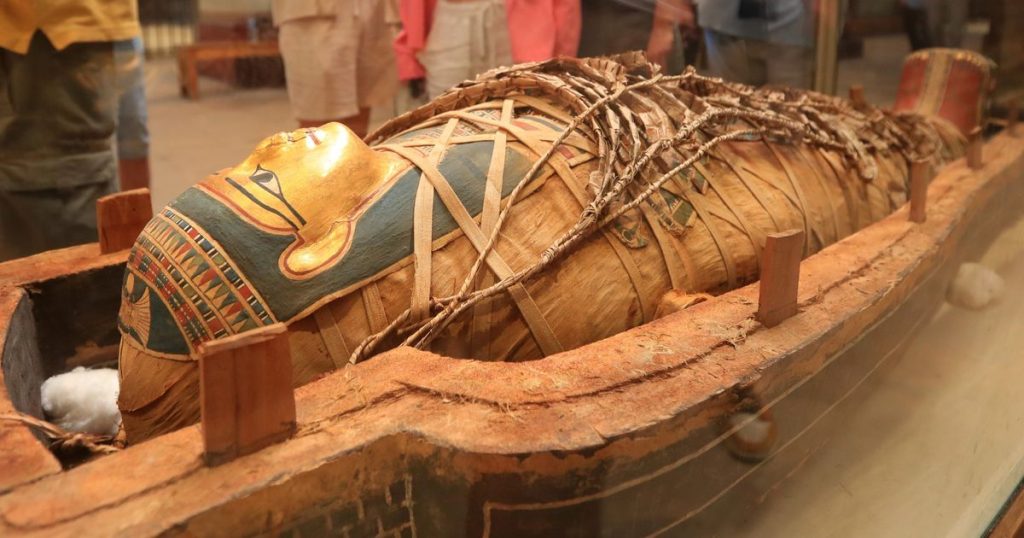In a fascinating study that combines archaeology, chemistry, and sensory exploration, researchers have uncovered the unexpected truth about the scent of ancient Egyptian mummies. Contrary to the gruesome imagery often portrayed in films and literature, where the act of smelling a mummy is depicted as repulsive or even dangerous, the reality is far more intriguing. A team of scientists from University College London (UCL) and the University of Ljubljana in Slovenia conducted a systematic investigation into the odor of mummies, some dating back an astonishing 5,000 years, and found that these well-preserved remains emit surprisingly pleasant aromas. Described as "woody," "spicy," and even "sweet," the scents were likened to those of fine wine, with hints of floral notes that could be traced back to the use of pine and juniper resins during the embalming process.
The research, published in the Journal of the American Chemical Society, involved a unique approach that relied on both advanced chemical analysis and a panel of human sniffers. The team examined nine mummies housed at the Egyptian Museum in Cairo, either in storage or on display, to determine the nature of their scent. Cecilia Bembibre, director of research at UCL’s Institute for Sustainable Heritage, explained that the study was driven by a long-standing curiosity about the smells associated with mummies. "In films and books, terrible things happen to those who smell mummified bodies," she remarked, "but we were surprised at the pleasantness of them." By avoiding direct sampling of the mummies themselves—an invasive and potentially damaging process—the researchers instead measured the air molecules emitted from the sarcophagi. This non-invasive method allowed them to distinguish between odors originating from the mummies, those introduced by conservation chemicals, and any signs of microbial degradation.
The findings of the study not only challenge popular perceptions but also shed light on the significance of scent in ancient Egyptian culture. Mummification was a complex and highly symbolic practice, reserved primarily for pharaohs and nobility, that aimed to preserve both the body and the spirit for the afterlife. The use of oils, waxes, and balms in this process was not only functional but also deeply meaningful, as pleasant smells were associated with purity, deities, and spiritual harmony, while unpleasant odors were linked to corruption and decay. By analyzing the scents of the mummies, the researchers hope to gain insights into the social status of the individuals they studied, as well as the materials and techniques used in their preservation. Matija Strlič, a chemistry professor at the University of Ljubljana, described the approach as akin to discovering the "Holy Grail" of preservation science, emphasizing its potential to reveal valuable information for conservators, archaeologists, and historians alike.
One of the most remarkable aspects of the study is the absence of any foul or decaying odors, which might have been expected given the age of the mummies. "We were quite worried that we might find notes or hints of decaying bodies," Strlič admitted, "but that wasn’t the case." The team detected no significant signs of microbial degradation, which speaks to the exceptional preservation conditions at the Egyptian Museum in Cairo. This discovery underscores the importance of maintaining controlled environments for the conservation of ancient artifacts, ensuring their survival for future generations. Barbara Huber, a postdoctoral researcher at the Max Planck Institute of Geoanthropology in Germany, who was not involved in the study, highlighted the broader implications of the findings. She noted that the research provides crucial data on the compounds that preserve or degrade mummified remains, which could be used to develop more effective conservation strategies. However, Huber also cautioned that the scents detected today are not necessarily the same as those present at the time of mummification, as thousands of years of evaporation, oxidation, and storage conditions have likely altered the original scent profile.
The study’s findings open up exciting possibilities for interdisciplinary collaboration and innovation. For instance, the researchers hope to use their discoveries to recreate the scents of ancient Egypt, potentially enhancing the museum experience for visitors. By developing "smellscapes" that artificially replicate the detected aromas, curators could provide a more immersive and multisensory engagement with history. Bembibre likened the traditional museum experience to being confined to a "white cube," where visitors are encouraged to observe artifacts from a distance, primarily through sight. "We don’t get to smell them," she said. "We don’t get to know about the mummification process in an experiential way, which is one of the ways that we understand and engage with the world." By incorporating scent into exhibitions, museums could offer a more lifelike connection to the past, allowing visitors to engage with history on a deeper and more personal level.
This research also builds on earlier efforts to explore the sensory dimensions of ancient cultures. For example, Huber previously conducted a study analyzing residue from a jar that once contained the mummified organs of a noblewoman, identifying the embalming ingredients used and their potential origins. She later collaborated with a perfumer to create a fragrance called "Scent of Eternity," which was featured in an exhibition at the Moesgaard Museum in Denmark. Such projects demonstrate the growing interest in the sensory aspects of history and their potential to enrich our understanding of ancient civilizations. While the study of mummy odors may seem unconventional, it exemplifies the creative and innovative approaches that researchers are taking to uncover the secrets of the past. By combining cutting-edge technology with a deeper appreciation for the sensory experiences of ancient cultures, this work not only challenges our assumptions but also invites us to reconsider how we engage with history in the present.
